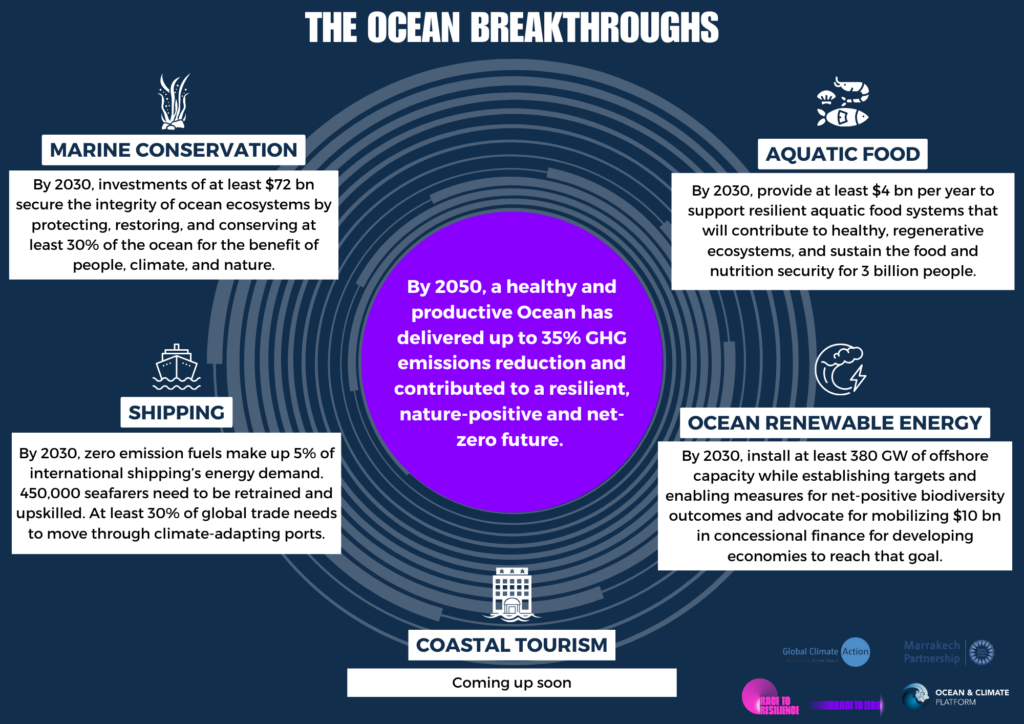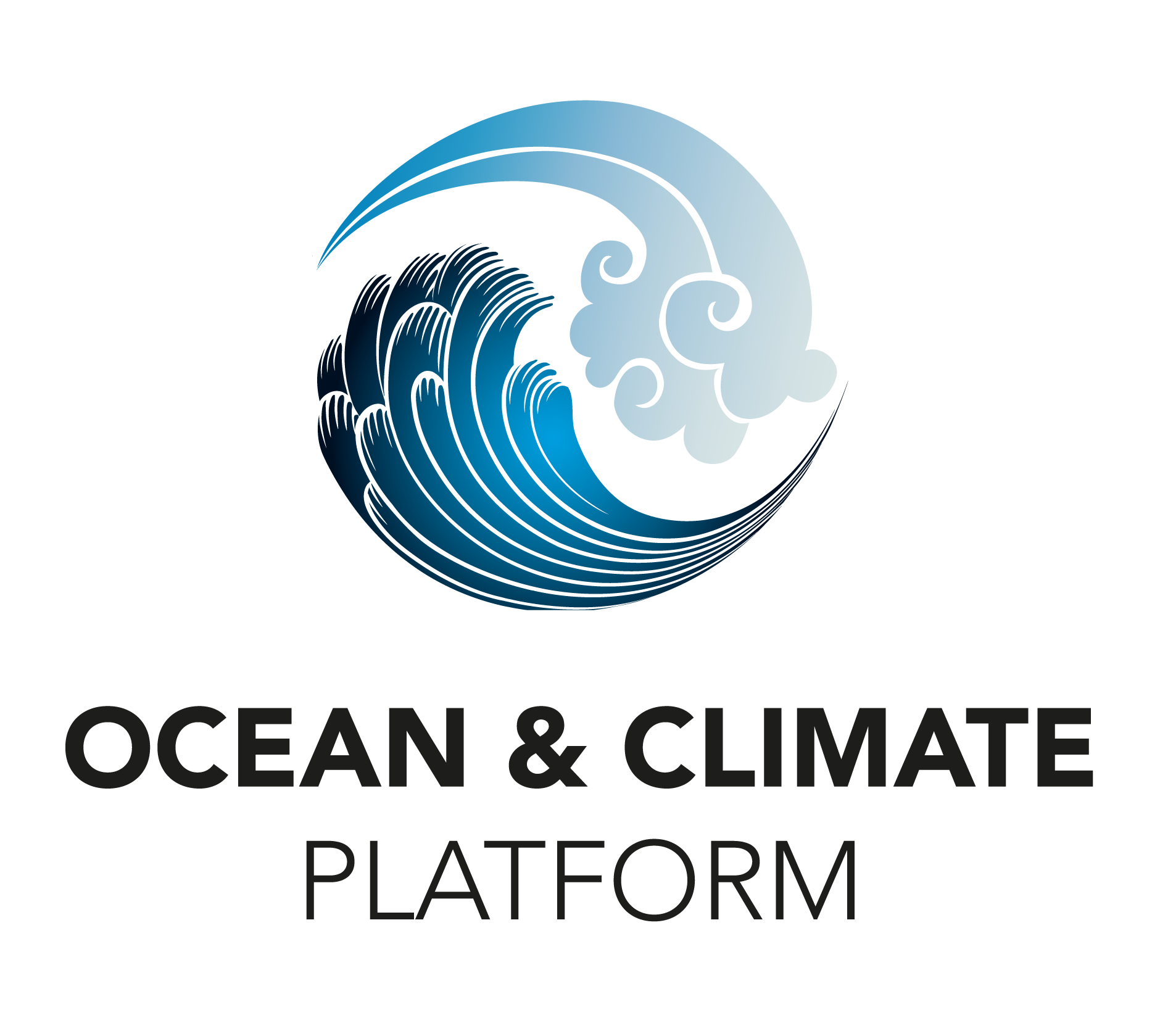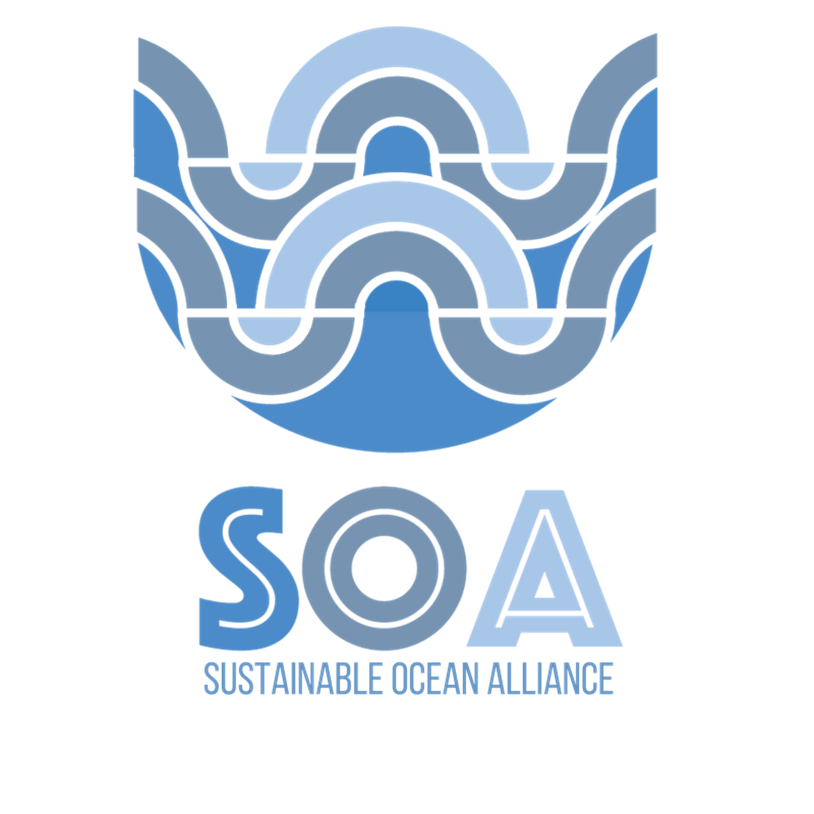By 2050, a healthy and productive Ocean has delivered up to 35 percent GHG emissions reductions and contributed to a resilient, nature-positive and net zero world
Concrete pathways to deliver on Nature and Climate goals Creating an Ambition Loop for Ocean-based Climate SolutionsThe ocean community, united under the Marrakech Partnership for Global Climate Action on Ocean & Coastal Zones, has designed a set of ocean pathways to drive the transition towards a net zero world, and further anchor the ocean in climate and biodiversity negotiations. This set of pathways – known as the “Ocean Breakthroughs” – shall be understood as tipping points to be reached by 2030, in order to deliver on the 2050 vision of the ocean designed by the Ocean for Climate Declaration.
To catalyze action, the Ocean Breakthroughs dive into 5 sectors: (1) marine conservation, (2) ocean renewable energy, (3) ocean-based transport, (4) aquatic food, and (5) coastal tourism, aiming to deliver on a fair, nature-positive and net zero future. The effective deployment of this vision relies on the cumulative action and close collaboration of stakeholders across sectors, a cross-cutting approach and key enablers (i.e., Science, Finance, Governance, and Inclusivity) to define objectives and quantifiable targets.
The Ocean Breakthroughs seek to support multilateral efforts, such as of the Paris Agreement, the Kunming-Montreal Global Biodiversity Framework and the Sustainable Development Goals, and contribute to the achievement of existing global targets, including the “30×30” (i.e., at least 30 percent of marine and coastal areas effectively conserved and managed by 2030). Launched ahead of COP28, the Ocean Breakthrough aims at feeding into the conclusions of the Global Stocktake, and ultimately to inspire ocean-climate action for the coming years.

The Global Stocktake
Convinced that strong leadership from Non-State Actors (NSAs) can positively influence governments and drive more ambitious public policies, the Ocean Breakthroughs are rooted in what is called the “Blue Ambition Loop” – a positive feedback loop in support of increasingly ambitious action.
To capture the state of NSAs action, the World Resources Institute, the UN Climate Change High-level Champions, the Ocean & Climate Platform, the Global Ocean Trust and the UN Global Compact, undertook in 2022 a mapping exercise to track, aggregate and visualise progress made by non-state actors towards ocean-based climate actions. The ‘Blue Ambition Loop: Achieving Ambitious 2030 Ocean-Climate Action’ report is a short visual summary of findings. The Ocean Breakthroughs focus on the same five key sectors (i.e. marine conservation, shipping, aquatic food, ocean renewable energy and coastal tourism).
While processes such as the Global Stocktake are in place to track government-led progress on ocean-climate actions. There is also a lack of data-based tools to measure non-state actors’ actions on ocean-climate actions and track their progress over time.
However, for NSAs to achieve the Ocean Breakthroughs, Sharm El Sheikh Adaptation Agenda and targets of the Global Biodiversity Framework, the Blue Ambition Loop needs to be activated.
Blue Ambition Loop ReportCatalyzing increased momentum for ocean-based climate action
The vast expanse of our oceans, from its mysterious abysses to its vibrant coasts, holds secrets yet to be unveiled. But one thing is certain: its indispensable role in making Earth a livable haven.
From the abysses to the coasts, much of the ocean, and the many wonders it holds, remain unexplored. Yet, its significance in sustaining life on our planet is undeniable. As a pivotal component of the global climate system, the ocean not only supports efforts to limit temperature rise but also bolsters resilience against climate impacts. Recent research led by the High-Level Panel on Ocean Sustainability indicates that full implementation of ocean-based climate solutions could reduce the “emissions gap” by up to 35 percent in 2050.
A myriad of initiatives from states, civil society organizations and the private sector have recently emerged, emphasizing the ocean’s role in climate dynamics and advocating for its inclusion in climate negotiations. These initiatives, including the Ocean for Climate Declaration, the Rise Up – Blue Call to Action or the Ocean Panel Call to action, have contributed to the recognition of the ocean as a reservoir of untapped solutions and innovation. The challenge now lies in translating these declarations into tangible actions.
With over 70 percent of new or updated Nationally Determined Contributions incorporating at least one ocean-based climate measure, the momentum is undeniable. As NSAs commit to even more ambitious ocean efforts, the call for all stakeholders to “swim the talk” becomes louder. As we approach COP28 and the culmination of the first Global Stocktake, it is now imperative to reflect on the past five years and chart out a blue “ambition loop” to accelerate the implementation of ocean-based solutions.
Dive in with us, be part of the Ocean Breakthrough, and let’s turn the tide together. As we harness the ocean’s potential, we inch closer to fulfilling the goals of the Paris Agreement.
Related Articles
Launch of the Ocean Breakthroughs: 5 pathways to catalyze action to achieve a healthy and productive ocean
The Ocean Breakthroughs are transformative pathways covering five key ocean sectors, where accelerated action and investments could deliver up to 35 percent GHG emissions reduction and contribute to a resilient, nature-positive and net zero future by 2050.
READ MOREAt COP15 it’s time for us to do a double shift to protect and revive Ocean biodiversity
A robust target must be agreed to strongly protect at least 30 per cent of the Ocean by 2030, writes Karen Sack, Executive Director, Ocean Risk and Resilience Action Alliance (ORRAA).
READ MOREGlobal Stocktake report underscores the need for greater urgency and stronger climate action across all levels of government, the economy, and society
There is still an urgent need to implement and scale up “a rigorous ‘all of economy, all of society approach’” this decade, according to the first-of-its-kind global stocktake technical report released today.
READ MOREHow the world’s largest seafood companies can help tackle climate change
Seafood firms can reduce their impact on climate and the oceans – and in doing so can ensure they have a long-term thriving business, writes Nigel Topping, UN High Level Champion for Climate Action at COP26.
READ MOREThe Ocean Breakthroughs are supported by the following organizations in their respective fields






















